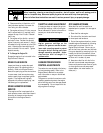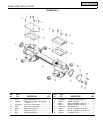
20 Section 5: Maintenance
Before inspecting, cleaning or servicing the machine, shut off engine, wait for all moving parts to
come to a complete stop, disconnect spark plug wire and move wire away from spark plug.
Failure to follow these instructions can result in serious personal injury or property damage.
WARNING
FORWARD CLUTCH
BAIL ADJUSTMENT
If the Forward Clutch Bail does not func-
tion properly, first check that the forward
drive belt is adjusted properly (see
Checking and Adjusting Forward Drive
Belt Tension). If this fails to correct the
problem, contact the factory Technical
Service Department or your authorized
dealer for service advice.
CHECKING AND ADJUSTING
REVERSE DRIVE BELT TENSION
(Models 12209/12210 only)
It is important to maintain correct tension
on the reverse drive belt. A loose belt will
cause the tines and wheels to slow down –
or stop completely – even though the
engine is running at full speed.
When checking belt tension, also check
the belt for cracks, cuts or frayed edges
and replace it as soon as possible.
• Check belt tension after the first two
hours of break-in operation and after
every 10 operating hours.
To Check Reverse Belt Tension:
1. Stop engine, wait for all parts to stop
moving and disconnect spark plug wire.
2. Remove screw in plastic belt cover and
slide belt cover (which is attached to for-
ward clutch cable) out of the way.
3. Have an assistant pull the Reverse
Clutch Control knob all the way out and
hold it in that position. Measure the
length of the cable wire between the end
of the threaded cable adjuster (A, Figure 5-
5) and the end of the z-fitting (B) to which
the cable wire is attached.
4. The belt tension is ideal if the cable wire
length measures between 1/8" to 1/4". If it
is less than 1/8" (and if there is no reverse
action when the tiller is running), then
make the following adjustments.
NOTE: If the length is more than 1/4", no
adjustment is needed—as long as the
reverse action functions properly.
5. Release the Reverse Clutch Control
knob.and then unthread the inner jam nut
(C, Figure 5-6) one to two turns. Pull the
threaded cable adjuster (A, Figure 5-6) to
the left until the inner jam nut (C) touches
the bracket.
6. Prevent the inner jam nut (C) from
turning and tighten the outer jam nut (D)
against the bracket. Prevent the outer jam
nut (D) from turning and tighten the inner
jam nut (C) against the bracket.
7. Measure the gap by repeating Step 3.
Readjust as needed by repeating Steps 5
and 6.
8. Reinstall the belt cover.
Replacement Belt Information
If the drive belt needs to be replaced, see
your local authorized dealer or refer to the
Parts List for ordering information. Use
only a factory-authorized belt as an “over-
the-counter” belt may not perform satis-
factorily. The procedure requires average
mechanical ability and commonly available
tools.
ENGINE CLEANING
Keeping the engine clean will help to
ensure smooth operation and prevent
damage from overheating. Refer to the
Engine Owner’s Manual for engine
cleaning service intervals and instructions.
Be sure that the muffler is cool before ser-
vicing the engine.
AIR CLEANER SERVICE
The air cleaner filters dirt and dust out of
the air before it enters the carburetor.
Operating the engine with a dirty, clogged
air filter can cause poor performance and
damage to the engine. Never operate the
engine without the air cleaner installed.
Inspect and service the air cleaner more
often if operating in very dusty or dirty
conditions. Refer to the Engine Owner’s
Manual for air cleaner service intervals
and instructions.
ENGINE OIL SERVICE
Check the engine oil level before each use
and after every 5 hours of continuous
operation. Running the engine when it is
low on oil will quickly ruin the engine.
It is recommended that you change the
motor oil after every 10 hours of operation
and even sooner when operating in
extremely dirty or dusty conditions. Refer
to the Engine Owner’s Manual for detailed
service instructions.
A. To Check the Engine Oil Level:
1. Park the tiller on a level area and shut
off the engine.
2. Level the engine (use the Depth Regu-
lator Lever to adjust the engine angle).
Figure 5-5: Measure cable wire length to
check for correct reverse belt tension.
A B
Figure 5-6: Move threaded
adjuster (A) to left to increase
belt tension.
D
C
A


















